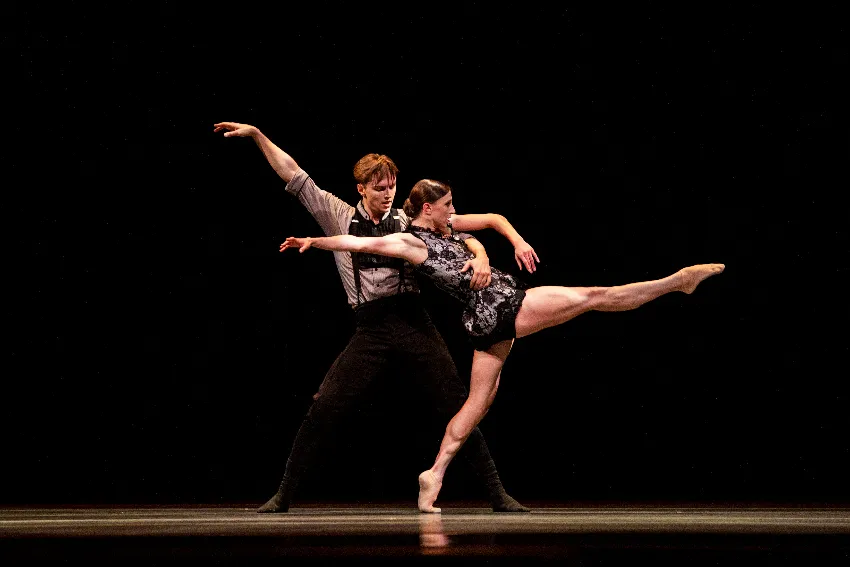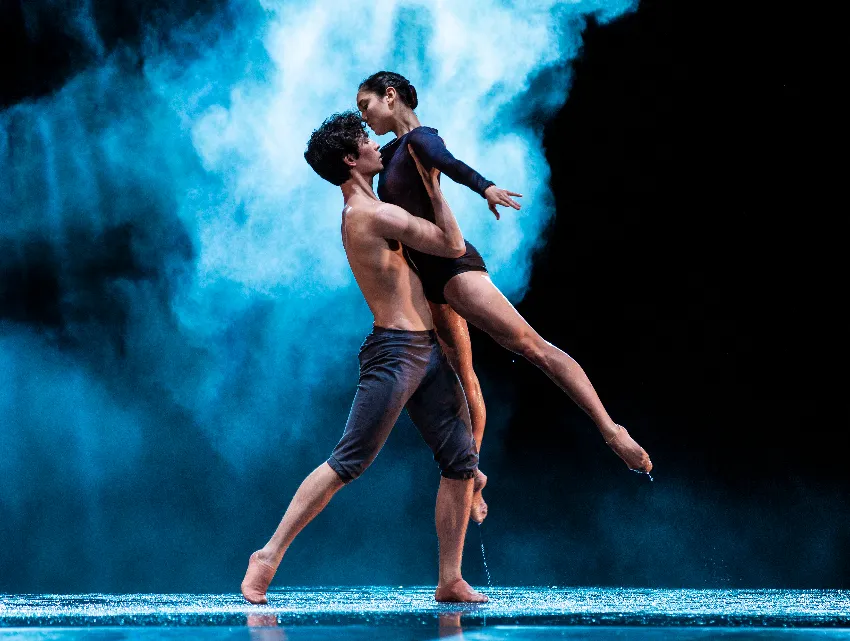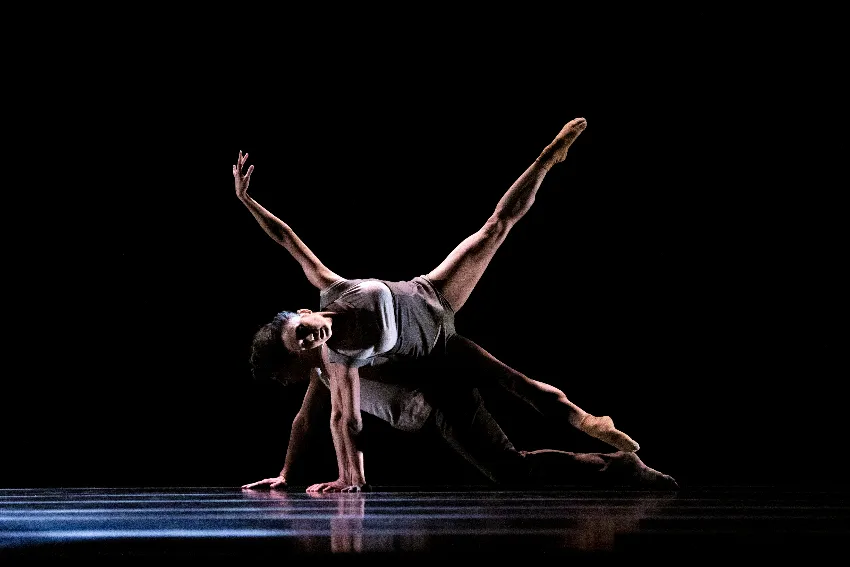PACIFIC NORTHWEST BALLET
SINGULARLY CERRUDO
Choreography by Alejandro Cerrudo
McCaw Hall
September 25, 2021
Until just the other night, the last time I was in an actual theater seeing a live arts performance was on February 21, 2020, when the Brazilian Dance company Grupo Corpo performed at UW's Meany Center for Performing Arts. On that evening I did what we all do when we have a night out to attend a concert, opera, poetry reading, or play – I met friends, had dinner in a restaurant, mingled in the lobby, and sat shoulder-to-shoulder with several hundred other arts lovers.
I never suspected that within two weeks the arts world would be compelled to close its doors; that restaurants would be reduced to passing take-out through a window; that we would no longer see our friends face to face. For almost a year and a half of COVID-19 lockdown, we endured social isolation unlike anything most of us have ever experienced. At the same time, our beloved Seattle arts organizations were struggling to rescue long-planned programs and to maintain company staff and audience loyalty. Ingenious uses of YouTube and Zoom figured largely in those efforts, and I really enjoyed seeing programs at home on my tablet. But no matter how clever and intimate the adaptations were, I still wanted to see people in the flesh who were acting, dancing, singing, and playing instruments right in front of my eyes.
So it was a tremendous joy to be in a theater again just last week – especially the beautiful McCaw Hall. Just driving to Seattle Center, strolling into the lobby under Sara Sze's fabulous chandelier sculpture, and seeing the box office open and the ushers at the base of the grand staircase were enough to make me feel like myself again. I loved seeing, once more, the rainbow walls, the dance sculptures, and Michael Spafford's mural Thirteen Ways of Looking at a Blackbird – but I was truly home when I entered the auditorium and saw the fabulous red velvet curtain with its starry spangles. I could have jumped over the orchestra pit and hugged that curtain.
Yet the greatest joy was seeing the curtain rise on Alejandro Cerrudo's wonderful dance program, which began with Silent Ghost followed by One Thousand Pieces (the dance that was supposed to go on stage in March 2020, but was postponed because of the pandemic). The show ended with the delightful Little mortal jump. Though each of these dances has premiered separately at PNB, this is the first time audiences will see Cerrudo's works together in one program–a concentrated view that shows us why Artistic Director Peter Boal selected him as PNB's resident choreographer. It demonstrates how well the PNB company dancers have embodied his distinctive dance style.
Cerrudo is what some call a "soft sock" choreographer–a term that may become the replacement for "modern dance" choreographer since bare or sock feet versus ballet toe shoes is no longer the distinguishing difference between modern dance and classical ballet. As more and more ballet companies embrace choreography that does not require dancing en pointe, the old distinctions make little sense. It requires as much skill, training, balance, and strength to do Cerrudo's dances as to do Balanchine's or Petipa's. This was an evening of dance that made you forget that the arched foot was ever a requirement of awe-inspiring ballet.

Music: Dustin Hamman, King Creosote & Jon Hopkins, Olafur Amalds, Nils Frahm
I first saw this dance in 2018 as part of the annual Director's Choice program, an evening of work by emerging choreographers and those whose work may not be familiar to Seattle audiences. This is what I wrote then – as true now as it was in 2018:
"Alejandro Cerrudo's Silent Ghost is for ten dancers in various configurations. I have no idea what the title means – it could have been called Dance X and still have been as moving to watch. Cerrudo's Little mortal jump was the hit of PNB's Director's Choice in 2016, so it was a real joy to see this wonderful dance-maker return.
"Cerrudo has developed many of his signature moves, especially the semaphore movements of the arms in which the dancers perform the simultaneous complexities together against a blank backdrop – almost like shadow figures. In Silent Ghost we see bird-like forms appear and disintegrate to compelling, sinuous music. In the opening sequence, as men take shapes that freeze and melt away, we see two dancers bent at the waist, arms outstretched, undulating from the hips to the finger-tips as if they were wands of kelp in a gentle stream. The inventions are too numerous and flowing to even remember, much less describe, but the unforgettable duet that ends the dance is so seamless, surprising, and elegant in its lifts, carries, and partnering that you can see what love is. That sounds corny, I know – but it's the truth. My dance buddy turned to me at the end and said, 'It gives me a reason to live to next Thursday.' I imagine that if he were to see Cerrudo's work every Thursday, he might live forever – or at least die happy."

Music: Philip Glass
When the pandemic canceled PNB's 2020 season, Peter Boal allowed ticket holders to see the final dress rehearsal of One Thousand Pieces online. Since it was a dress rehearsal, I couldn't publish a review of it (it would have been unfair while they were still practicing), but I was thrilled then, and I'm thrilled now by its return. Here's what I wrote a year and a half ago:
"Cerrudo's style is very distinctive, uniquely inventive, and increasingly complex and moving. Little mortal jump was great, but believe me when I tell you that as soon as we're all out of lockdown, you should celebrate by going to see One Thousand Pieces. The music by Philip Glass, the intricacy and power of the choreography, the intense commitment of the dancers, and the exquisite musicianship of the PNB orchestra all combine to make a work that will live forever. And to think that Cerrudo is creating an entirely new work for PNB – and for us – next year."
So this past week, when I could finally join subscribers in the socially-distanced audience at McCaw Hall and see the live premier of One Thousand Pieces, I can report on what was so astonishing. The dancers perform on a field of water with a shower of mist behind them. It sounds dangerous, and they perform as many daring lifts, swings, and balances while splashing and sliding on water as in dances on dry ground. But Philip Glass's music is slow and mesmerizing, allowing the dance to be equally slow and mesmerizing. Like the rest of Cerrudo's style, the dance is very low to the ground, lifts are distinctively anchored against the floor, and the glory is sculptural rather than daring. Cerrudo reports that he was inspired by Marc Chagall's America Windows at the Art Institute of Chicago, and you can see the relationship between the water, the slow movement, and the crystalline effect of the poses. This is a dance that lifts the veil for me – I can see another world beyond this world. Mark Morris is the only other contemporary choreographer who does that for me.

Music: Various Artists, including Philip Glass, Max Richter, and Tom Waits
This terrific dance was originally premiered by PNB on March 18, 2016, along with Justin Peck's Year of the Rabbit. Peck's work was so greatly anticipated that it had an entire documentary made about its creation. Yet, as you can see from the review I wrote then, Cerrudo was the clear favorite of the evening:
"Of three marvelous dances in the evening's program [the third was Paul Gibson's Rush], this was my and the audience's favorite, prompting McCaw Hall to erupt into shouts of amazement and delight at the end. Little mortal jump is funny, mysterious, and startling. For some undisclosed reason, the men are dressed like 1930s newsboys, in knickerbockers and suspenders, while the women are in more contemporary, cool-looking jumpsuits and skirts. The stage contains four huge black boxes that dancers stand on, disappear into, and ultimately send spinning across the stage in a finale that defies logic but strikes at that place in your chest where the thrills vibrate.
"In the opening section a single male dancer comes out and performs a tour de force of body language and dance acrobatics that concludes with – well, I'd better not tell you (no spoilers), but it caused a collective gasp and a wave of laughter from the orchestra to the top tier. The sections that follow – duets interspersed with sequences for all ten dancers – display a style of movement that uses every part of the body independently, as though the head and arms were inexplicably independent of the torso, and the skeleton inside is a flowing liquid rather than a solid. This may sound weird, but it isn't. It actually does what great dance always does – it gives us a new understanding of what the human body can do. One aspect of Cerrudo's choreography that I loved is his use of simultaneous movement in groups – all ten dancers moving together in a kind of semaphore communication that bypasses the left brain and goes straight to the heart. Little mortal dance is the first work I've seen by Cerrudo and my antennae are out now – I want to see everything he's ever made."
Thanks to Peter Boal's great choice of a resident choreographer, and thanks to the wonderful dancers in the PNB company, Seattle dance lovers will probably get my wish. You can return to McCaw Hall for this program if you're a subscriber; otherwise, buy tickets for streaming performances October 7 – 11. Access is available for purchase until October 11 at 7 p.m. Go to https://www.pnb.org/season/singularly-cerrudo/.

